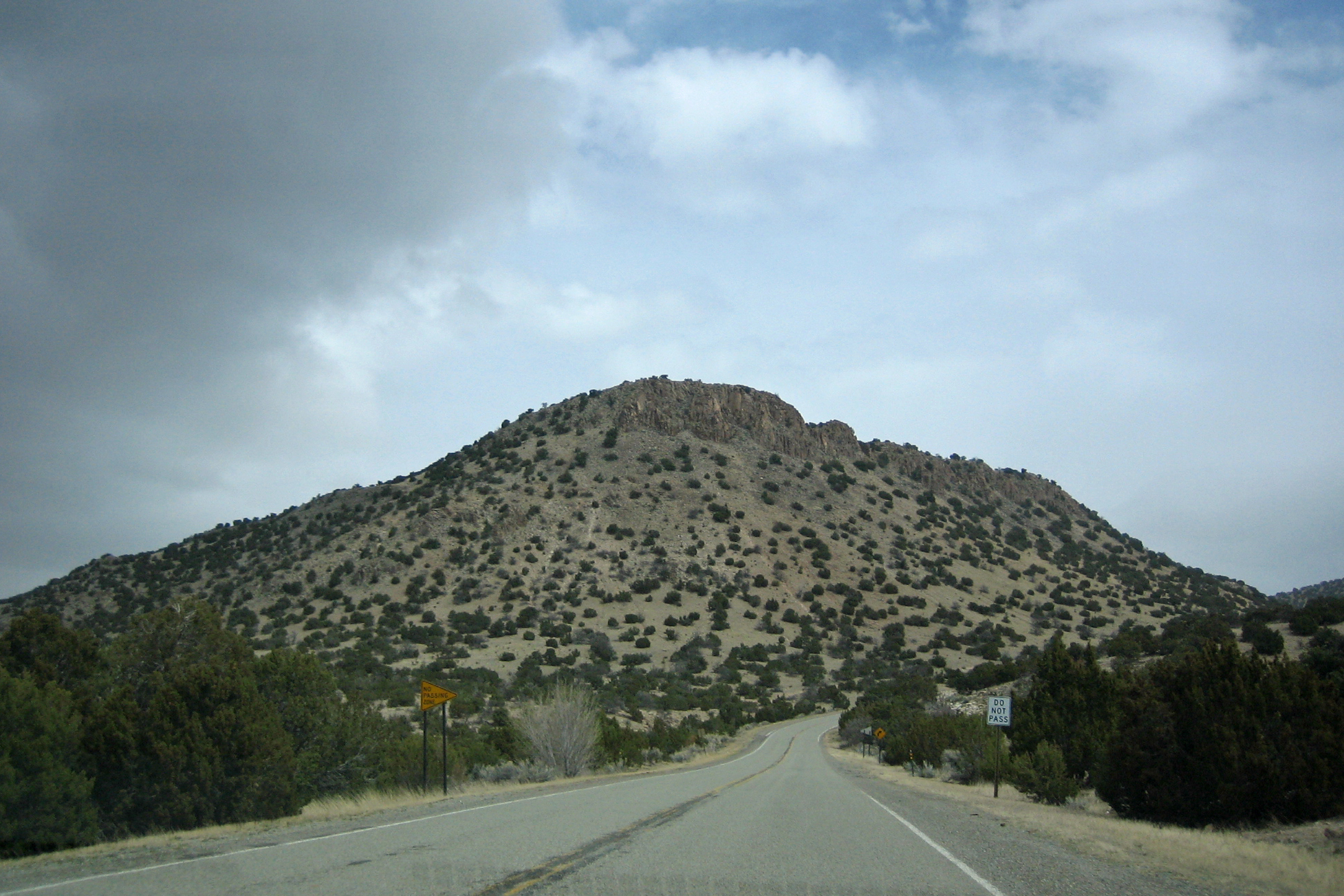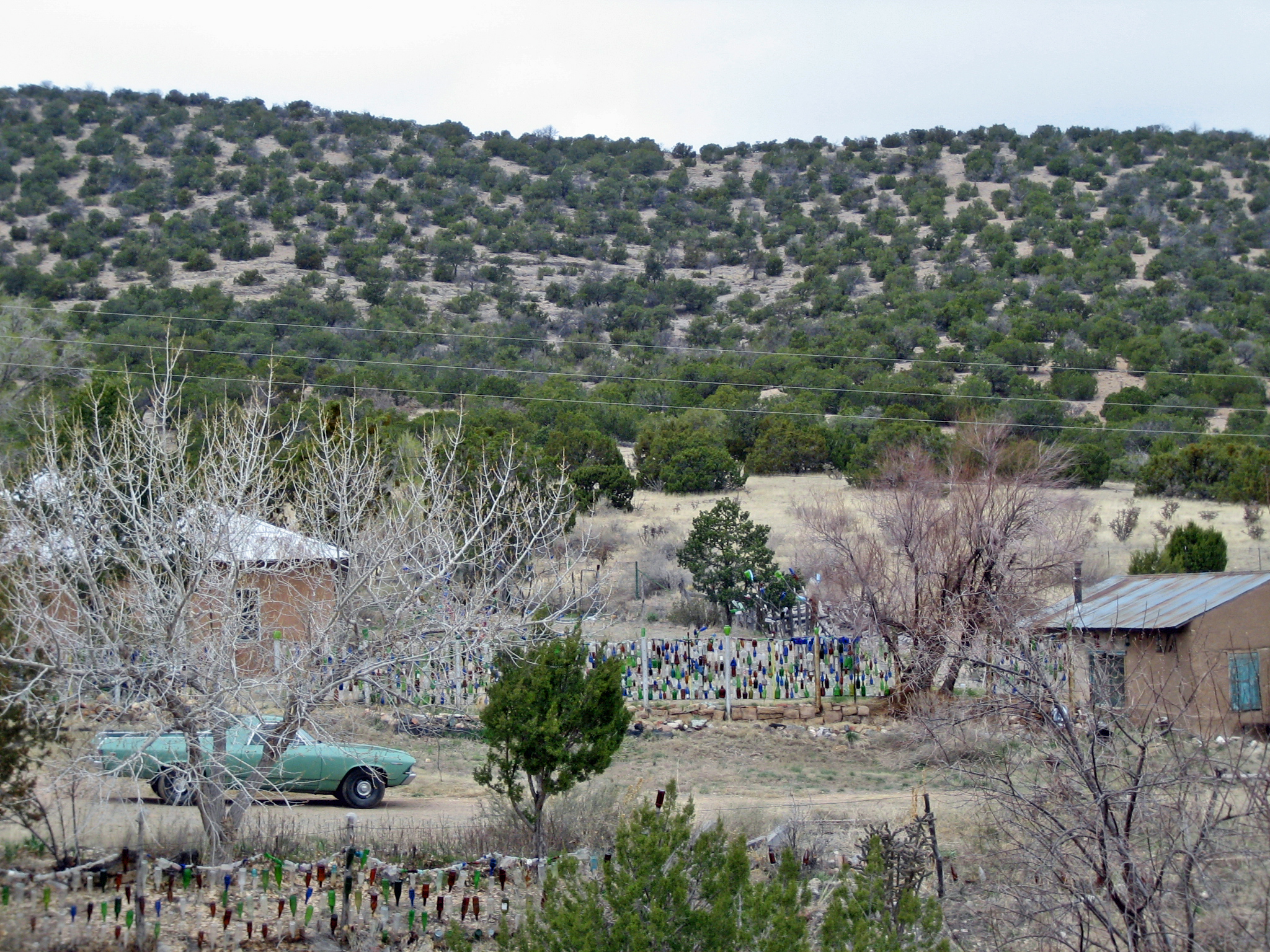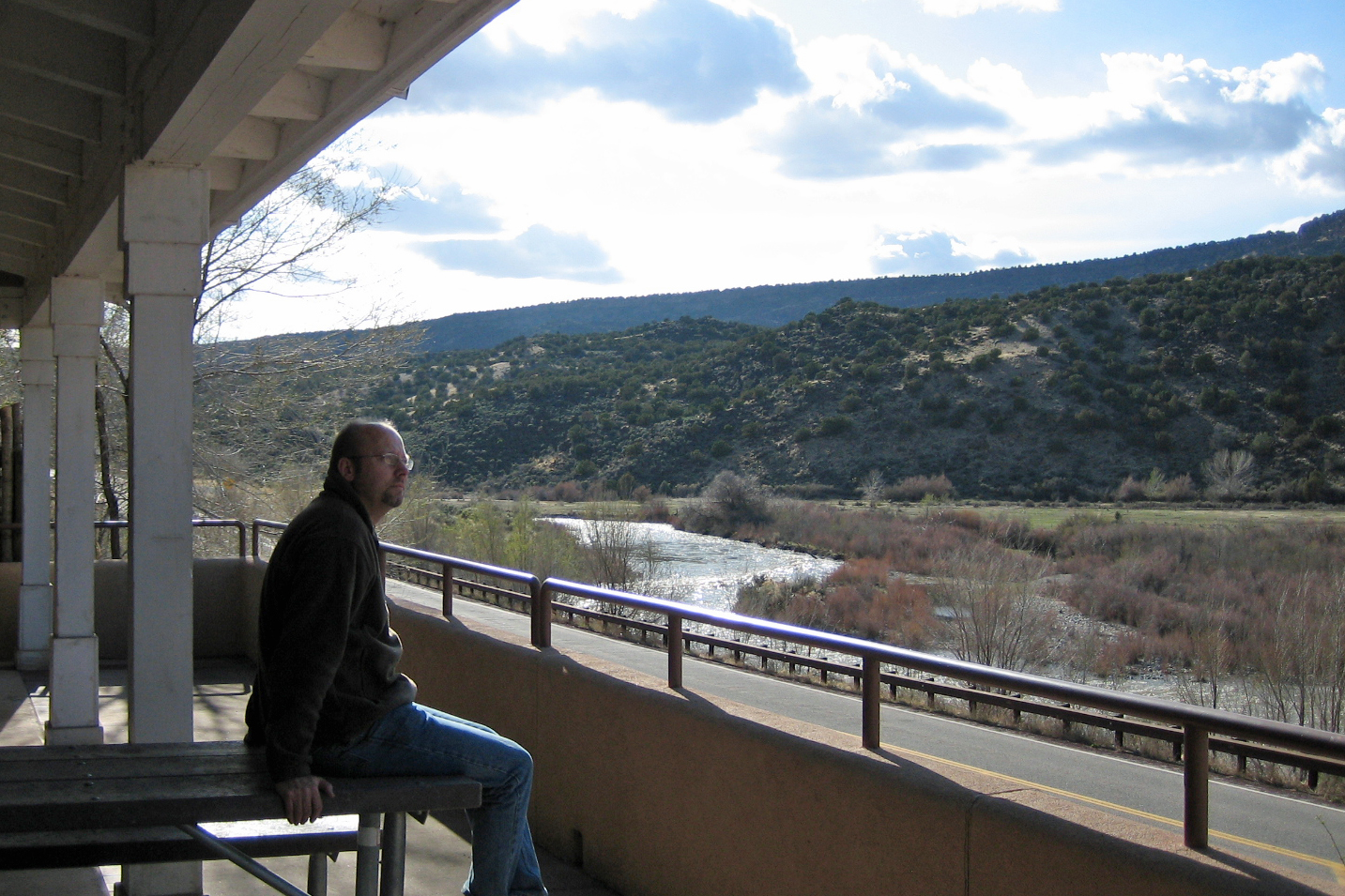
We got a bit of a late start and decided to grab a bite to eat before heading out of Albuquerque. Despite how non-descript the area feels to me, the mountains around here are pretty stunning. Yesterday, I was waxing poetic about how different the Sandia Mountains are to those we see in Puerto Rico. In PR, everything is lush and green and the rain clouds hug the mountain tops. Here, yesterday, the peaks of the Sandia Mountains were stretching fully into the sky with the clouds maintaining what seemed like a respectful distance. This morning, however, the clouds have descended and are obscuring the tops of the mountains. The sky here in Albuquerque is bright blue, but there’s talk of some storms further north, even a little snow, which seems impossible from where we’re sitting.
Chris points us towards The Range Cafe, a restaurant he visited during one of his sleuthing trips. It delights. It’s cool and funky, just the gem you want Albuquerque to show you. The chair rail reaching around the room carries a strip of mosaics that shift every two feet or so — bright fishies swimming through shards of irridescent blue glass, a sweet roll and cappucino rendered in glazed ceramic, stained glass cactus and hand-painted cowboy boots.
We continue with what we decide will be a culinary theme of our trip — Huevos Rancheros of the Southwest. Here, the variation includes white cheddar cheese and a yummy blue corn tortilla, plus two kinds of chili. And while I’ve never met a potato I didn’t like, the home fries served on the side just seem superfluous and, somehow, ingenuine. We declare this our favorite entry so far and worry a little about what our tummies will declare later on.
We’re taking what is called the Turquoise Trail up to Santa Fe today, at which point we’ll see if we have time to take the scenic route to Taos or the more direct route. What’s slightly amazing to me is that we start our trip on US 40 and, although we’re hundreds of miles away, I’m on the very same highway I used to drive nearly daily when in St. Louis. It feels connected and sweet and nostalgic to know that if I wanted to, I could just keep going and this road would take me all the way back there.
The mountains on either side of the road look like they’re from a model train set — all sandy and dotted with rough green bushes, like the kind you made by wetting down green tissue paper and squishing it into a clump. It’s a pretty forbidding landscape and even though the summer weather will warm the surrounding tones in a month or so, it’s still hard to imagine that anyone saw in this an invitation hundreds of years ago, and decided to build homes, forcing their roots down through unwelcoming soil. It says something about the people here, speaks to a resilience that works its way from the inside out, hardening the skin as much as the sun and the elements.
At Exit 175, a mobile home coming in the opposite direction has a strip of snow across its bumper and, suddenly, we are driving through a sparse flurry that dissipates as suddenly as it appears. Strange.
It is 52 miles from Albuquerque to Santa Fe on the Turquoise Trail, which officially begins when you exit Highway 40 and take 14 North. As if it knows where we are, our iPod kicks in the distinct Southwesterny horns of The Mavericks’ "Dance the Night Away" and I get that surreal feeling I get sometimes, like my life is a movie and this is the soundtrack and we’re getting to one of the interesting bits.
You can take hours, we’re told, to drive the Trail, stopping at every point along the way — the tiny town of Tijeras; the archeological museum in Cedar Crest; the Tinkertown Museum in Sandia Park. You can take a side trip into Sandia Mountains Cibola National Forest and drive to the Sandia Crest, the mountain’s highest point at 10,000 feet. You can stop in Golden, where the first gold rush west of the Mississippi took place. But we don’t. We’re trucking, digging the serenity of our drive, gaping and gawking at the landscape.
We pull off the road in Madrid, a former coal mining town that was revived in the 1970s by artists and is now a funky little community that mixes hoaky museums — the Rattlesnake Museum, the Old Coal Mine Museum — with working artist’s studios and souvenir shops. As of the 2000 census, the population was 149. Remember that episode of the Brady Bunch when they get stuck in the old Western town? It feels a bit like that, only much funkier.
We pull off the road in Madrid, a former coal mining town that was revived in the 1970s by artists and is now a funky little community that mixes hoaky museums — the Rattlesnake Museum, the — with working artist’s studios and souvenir shops. As of the 2000 census, the population was 149. Remember that episode of the Brady Bunch when they get stuck in the old Western town? It feels a bit like that, only much funkier.Our first plan of action is to use the restrooms inside The Mine Shaft Tavern. Having tourist guilt, we order up a cup of coffee to earn our entree into the toilets. This place is the real deal, dim inside on account of all the wood — from floor to ceiling — soaking up the sunlight. There’s an honest-to-goodness ancient cowboy at the bar, drinking a bottle of Coors before noon, complete with waxed moustache, shoulder length grey hair, worn brown suede hat, a jean jacket studded with rivets. He smokes hand-rolled cigarettes and a pair of worn, creased leather work gloves sticks out from his back pockets. A sign above the bar, posted in between old west murals, reads: "Welcome to Madrid. There is no town drunk — we all take turns."
The roof’s held up with large wooden beams, laquered to a brilliant shine, and the bar is constructed of logs. There’s a stage that attracts acts from all around and the stage lights rigged to shine in its direction are covered with old coffee cans painted black and coated with what looks like decades’ worth of dust. At the opposite end of the room, a buffalo head gazes down from above the brick fireplace.
If I had to pinpoint what exactly separates the new Southwest from the Old West, I’d probably start with the yoga flier in the bathroom and the machine that gives out free condoms but warns, via a hand-lettered sign, that "quantity won’t improve your odds or your looks."
Everyone here is friendly — the waitress turns out to be relieved that we only want beverages. She’s having a busy day, tables crowded with tourist families, a group of retiree golfers from the resort up the road, upscale shopping ladies with expensive scarves and funky woven jackets, locals ordering up "the usual." Heading out, we first check out the small collection of shops right by the Tavern. There’s a genuineness here that seems to far surpass anything we saw in Old Town. The stores are tiny, many of them converted from the former mining company buildings.
We stop in an herb and tea shop, outside of which is a table offering up small hunks of minerals, each with a handwritten note detailing its specific promises — everything from confidence to peace to strength. Inside, the beautiful young woman who runs the place tells us she makes custom herbal blends, offers us up some variations. "Lover’s blend?" she says, smiling broadly. In a little shanty attached to her store proper, constructed, it seems, of tree branches and found objects, she also sells some hand-knit hats, a few items of clothing, some dusty old bottles and ceramic mirrors. It’s a crazy, ecclectic mix and probably says everything you need to know about Madrid.
At the next shop, a woman sells jewelry, much of it silver and turquoise. Some of it is by artisans on nearby pueblos (that’s Indian reservation to the uninitiated), but much of it she has made herself, even hand-mining the turquoise on the land she owns. As I mentioned, I’m not a huge fan of turquoise, but her stuff is really lovely. It’s called Cerrillos turquoise and has a much paler, greener hue to it than the fakey deep blue stuff we’re used to seeing in shops, much of which is manufactured. There I buy a lovely little copper cuff bracelet by a local artist, stamped with tiny suns, moons and stars, forgetting — or choosing to ignore — that it will turn my wrist green in no time. At $12, it’s a steal.
At a small gallery just a few paces away, Color & Light, I fall in love with these amazing enamel/metallic/tile pieces by a local artist named Zingaro. Yes, he goes by the one name. I like his stuff anyway. I’m still not clear on the process, but the result are these mosaic-slash-montages of coppery enamel tiles, some with silk-screen imprints of flowers rendered in powdered metal. They’re like rich, deep quilts of tremendous hues. The piece I like best is the largest one featuring lots of burnt orange, yellow and red. It costs $3,200. And for one, brief moment, I seriously consider the credit line on my Visa and the freelance projects looming on the horizon. At that moment, $3,200 seems a perfectly reasonable amount to spend on a piece of art that was, after all, so clearly made for me.
Logic, however, prevails. The gallery owner is tremendously generous with information, showing me some work of Zingaro’s that she doesn’t have room yet to display. She gives me her card, tells me he’s doing some smaller pieces for her in the $200-$300 range which, at that point, sounds like pocket change.
It turns out that the "main drag" of Madrid is a few yards yet up the road, a dusty two-lane affair. Former homes have been transferred into shops selling everything that could possibly be filed (sometimes dubiously) under the heading of "art." Much of it is produced locally, some by artists in town or the surrounding area, many of them Native American (American Indian? It gets confusing what’s the right term) artists.
It’s a strange day weather-wise at this point, the sun wrestling with the clouds, the air warm one minute then chilly the next. Also strange, but not weather-related, are the number of posters for the movie "Wild Hogs," starring John Travolta, William H. Macy (why?), Tim Allen and Martin Lawrence. Fortunately, it isn’t just that this is a town full of people with bad taste in film. They’re just a little proud about Madrid’s latest claim to fame. Apparently, the movie was both set in and filmed in Madrid. In fact, one of the more inviting storefronts, a pretty purple diner, turns out to be a set, built for the film.
As I’ve mentioned before, our timing for this trip is – depending on your perspective – either a bit off or right on. We’re hitting the area in the last week of ski season and well before the busy summer tourist months kick in. It means that a lot of the shops are closed, which kind of gives Madrid a ghost-town feel in spots, which seems entirely appropriate.
We easily killed a couple of hours just hanging in a town probably no bigger than a city block or two and, as we headed back to the car, the oddest thing happened – it started to hail, tiny pea-sized orbs that stuck in my hair and landed softly on the fleece of my jacket. Somehow, it seemed perfectly natural that such a thing would happen in Madrid.
On the road again
Back in the car, heading north, we zip on up the road, hail behind us, passing the rather spooky-looking Allentown prison. Somehow, we miss the bypass road for Santa Fe and are sentenced to crawl through a main drag of low-slung fake adobe strip malls. When we pick our way over to 84/285 North to Taos, light snow is flurrying around the car. Then, just north of Santa Fe, the sun is shining brightly and for a short time, perhaps 1/8 of a mile or so, we have both light snow and bursting sunlight.
The landscape along the highway is broken by billboards for the casinos on the pueblos that flank either side of the road. Straight ahead of us, mountain ridges glow rose-colored in the afternoon sun even as a dark grey curtain of clouds glowers behind them. If the signs here are to be believed, drunk driving clamp-down is fierce, new members get free slots, and the correctional department, a happy-looking bunch, is hiring. Also, you might win $1 million, one of four new cars, or just your turn at an all-you-can-eat buffet.
In the town of Espanola, the RV park boasts a day spa. Only in the Southwest, people. The sign says they do permanent make-up and all I can picture are trailer park ladies getting bright-blue eye shadow, brown pencil eyebrows and carnation pink lipstick forever emblazoned on their skin. As we pass a sign for a tattoo parlor, Chris says, "I want a giant tattoo of a dream catcher on my back." He pauses for a moment. "Or maybe that Indian crying about the trash."
We are taking the low road to Taos, saving the scenic but slower high road for the drive back. This path follows alongside the Rio Grande, although we are driving against the current. It curls us through mountains that tower above us, raw and jagged, deep pink in places like open wounds, pale as sand in others, rippling into themselves like the folds of a skirt. The Rio Grande fairly rushes in some points fueled, I suppose, by melting snow in points further north. We are staying at Casita Montoya (yes, as in, "my name is Inigo Montoya," dot dot dot), which is within walking distance of the Plaza and the main shopping intersections of Taos. It’s a lovely little place, with a kitchen, living room, bedroom, a kiva fireplace in the corner and a hot tub out back. Suitable for people of our class.
We hoof the block or so into town, passing an unsettling number of angry dogs tethered by what seem rather flimsy fences or lengths of string. Why are the dogs of Taos so upset? It’s gorgeous here. The snow-covered peak of Taos Mountain looms in the distance, the town – population around 6,000 – is full of shops, cafes, galleries, etc. Everything is well-kept and the streets are relatively quiet since we’re not heavily into tourist season. A dog should be happy.
From this point on, we proceeded to do a lot of nothing – some reading, some relaxing, some soaking in the hot-tub. We dine that evening at a local favorite called Orlando’s, a small brightly-painted spot that serves up New Mexican fare. While we wait for a table, we sit outside on wrought iron chairs placed around two open-pit fires that provide more smoke than warmth in the air that is fast chilling as the sun goes down.
There’s a fake cowboy, who grumbles when a local stirs the fire and accidentally sends ashes flying in his direction. He’s maybe 60 or so, all dudded out in brand new pressed jeans, giant turquoise bolo, pristine hat and leather gloves (which may be Isotoners). His jacket is seeping fringe and he’s drinking a California red. He rests his Ostrich-skin cowboy boots on the edge of the metal fire pit. It must have cost a fortune, this outfit. As he grouses about the ash landing on his jacket, his wife smiles apologetically at everyone around them, then turns and assures the faux cowboy that he’s alright. I get the feeling she does this a lot. I think in his day job, he’s either a car salesman. Or a basketball coach. Something that makes you think you’re important but doesn’t require you to have any manners.
We end our first night in Taos with a dip in the hot tub. It’s probably 30 degrees outside and we fairly steam as we rest our heads backwards and gaze, wordlessly, at a sky so full of stars it’s like they ordered up extra just to show us how it’s done. Or maybe the fake cowboy paid to have them shipped in. Either way, it’s glorious.







